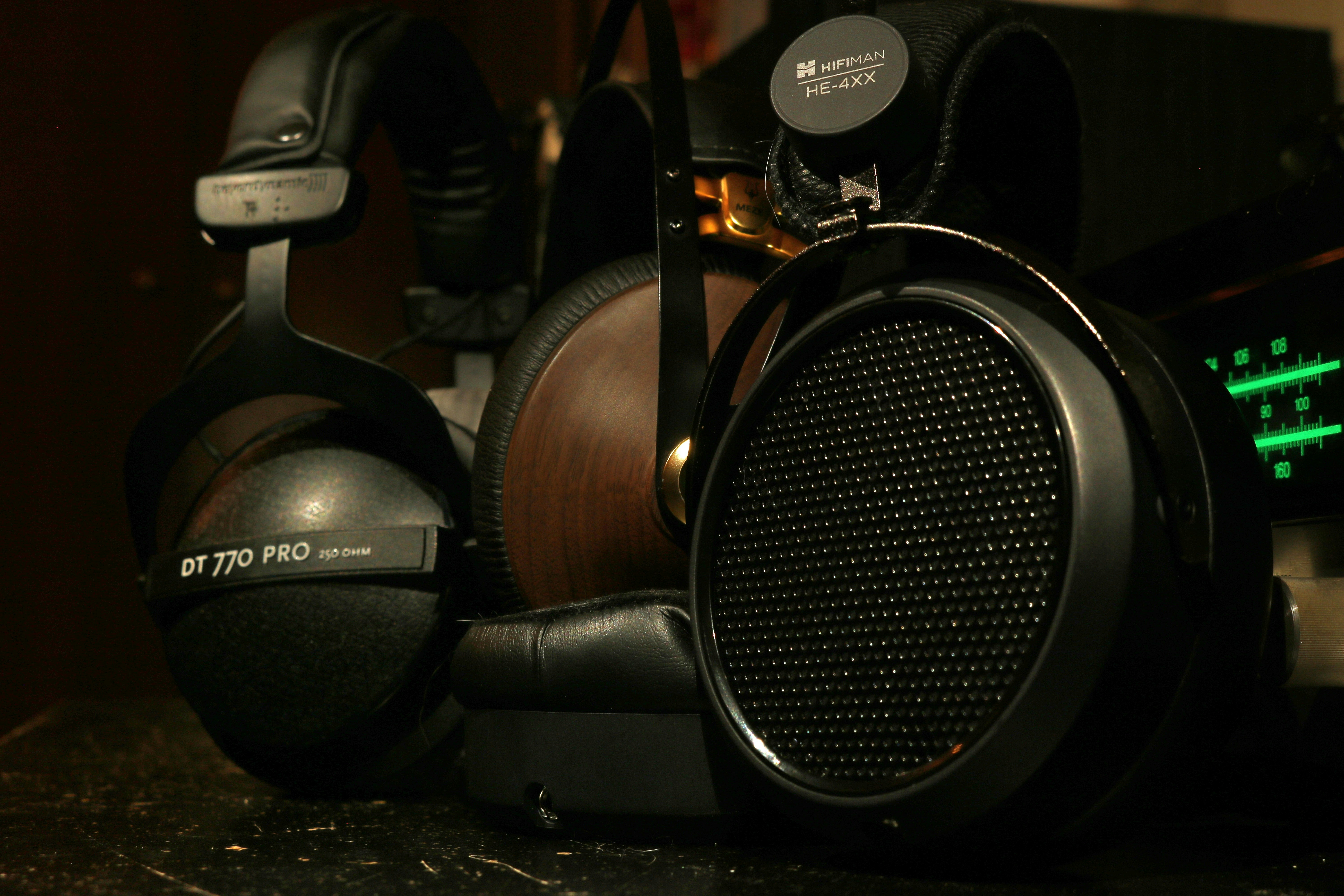
Headphones Buying Guide in 2025
Share this content:
Introduction to On-Ear and Over-Ear Headphones
The world of audio equipment has evolved significantly, with on-ear and over-ear headphones emerging as popular choices among consumers. Unlike earbuds, which offer a minimalist design and portability, these full-sized headphones provide an enhanced auditory experience that appeals to a wide range of users. Understanding the distinctions between on-ear and over-ear headphones is essential for making an informed purchasing decision.
On-ear headphones are designed to rest directly on the outer ear, creating a compact form factor. They often deliver adequate sound quality while being lighter and more portable than over-ear models. On the other hand, over-ear headphones encompass the entire ear, which contributes to a more immersive sound experience by effectively isolating external noise. This characteristic makes them particularly attractive for audiophiles and individuals seeking high-fidelity sound reproduction.
One key reason for the growing preference for these headphone types can be attributed to the superior sound quality they provide compared to smaller alternatives. While earbuds can be convenient for casual listening, they often lack the depth and richness of sound that on-ear and over-ear headphones can deliver. Moreover, with advancements in technology, these headphones now feature enhanced comfort and ergonomic designs, allowing for extended listening sessions without discomfort.
Consumer preferences also play a significant role in the increasing demand for full-sized headphones. Many users prefer a more dependable sound experience for activities such as gaming, music production, or simply enjoying their favorite albums. As individuals seek out more versatile audio solutions, on-ear and over-ear headphones have cemented their places in the market, becoming essential companions for those who prioritize quality and comfort in their listening experiences.
Popular On-Ear and Over-Ear Headphones Reviewed
In the realm of audio equipment, certain headphone models have distinguished themselves through their performance, design, and user satisfaction. This section highlights notable examples of on-ear and over-ear headphones that have received widespread acclaim.
One leading model in the on-ear category is the Bose SoundLink On-Ear Bluetooth Headphones. Renowned for their balanced sound profile and impressive battery life, these headphones boast a lightweight design that enhances comfort during extended use. Users frequently praise their noise isolation capabilities, making them a solid choice for both casual listeners and audiophiles alike.
Moving to the over-ear segment, the Sony WH-1000XM5 stands out. These headphones offer exceptional noise cancellation technology, allowing users to immerse themselves fully in their music without distractions. The design of the WH-1000XM5 is sleek and modern, featuring plush ear cups that ensure comfort during lengthy listening sessions. Feedback from users often highlights their superior sound quality and the convenience of touch controls.
Another popular on-ear option is the Sennheiser PX 200-II. This model is appreciated for its compact size and portability, making it an excellent partner for travel. Users report that the sound quality is impressive, especially considering the headphones’ affordability. The PX 200-II combines style with function, appealing to those who appreciate a balance of performance and aesthetics.
Finally, the Audio-Technica ATH-M50x over-ear headphones have garnered a dedicated following among professionals and enthusiasts. Known for their robust build quality and exceptional audio fidelity, the ATH-M50x is often recommended for studio use and casual listening. Users find that their ability to reproduce accurate sound makes them a reliable choice for critical listening tasks.
In conclusion, a diverse range of on-ear and over-ear headphones currently dominate the market, catering to varying preferences and budgets. Each model reviewed here embodies unique features that enhance the listening experience, making them worthy of consideration for potential buyers.
Comparative Breakdown by Features
When choosing between on-ear and over-ear headphones, several key features should be taken into account that significantly affect the listening experience. Understanding these elements can help consumers make informed decisions.
Sound quality is often cited as a critical factor in headphone selection. Over-ear headphones typically provide a more immersive sound experience due to their larger ear cups that encapsulate the ear. This design enhances bass response and allows for clearer separation of audio elements. Conversely, on-ear models, while still offering admirable audio quality, may not achieve the same depth of sound as their over-ear counterparts, which can lead to a slightly less engaging listening experience.
Comfort is another important area to consider. Over-ear headphones are generally regarded as more comfortable for extended use, as the cushioned pads surround the ear entirely, creating a soft barrier that mitigates ear fatigue. On-ear headphones rest on the ear, which can lead to discomfort during prolonged listening sessions, especially for those with larger ears or sensitive skin.
Battery life varies notably between these two styles, particularly in wireless options. Over-ear headphones often house larger batteries, yielding longer playtime, which can extend upwards of 30 hours on a single charge. On-ear wireless headphones tend to have a shorter battery life due to their compact design, with many models offering around 15-20 hours of usage.
Noise cancellation features also need to be factored into the decision. Over-ear headphones typically provide superior passive noise isolation due to their enveloping design and can also include advanced active noise cancellation technology to block external sounds. On-ear headphones may offer some noise isolation but are less effective in preventing ambient noise interference.
Portability is another point of distinction; on-ear headphones usually provide a lightweight and foldable design, making them easier to travel with. In contrast, over-ear models can be bulkier, although many brands are now producing collapsible designs that improve portability.
Finally, build quality plays a significant role, with over-ear headphones often employing more robust materials, translating to greater durability. On-ear models, while often crafted from lighter materials for comfort, may not always match the long-lasting quality of their over-ear counterparts.
- BREATHTAKING AUDIO QUALITY — Apple-designed dynamic driver provides high-fidelity audio. Computational audio combines cu…
- FOCUS ON WHAT’S PLAYING — Active Noise Cancellation blocks outside noise so you can immerse yourself in music.
- HEAR THE WORLD AROUND YOU — Transparency mode lets you hear and interact with the world around you.
Price Range and Budget Considerations
When it comes to selecting headphones, understanding the price range and budget considerations is crucial. On-ear and over-ear headphones can vary significantly in cost depending on their features, brand, and performance. It is essential to recognize that different price categories will offer various advantages, influencing purchasing decisions.
For entry-level headphones, which typically fall under the $50 price range, consumers can expect a basic sound quality and minimal additional features. Some reputable brands provide on-ear models within this price range, which may be suitable for casual listening. However, those looking for durability or advanced audio performance may find themselves lacking in this category. Overall, entry-level options are ideal for novices or those who prioritize affordability.
Mid-range headphones, generally priced between $50 to $150, offer a more balanced combination of sound quality and features. This price range often includes both on-ear and over-ear models that incorporate better materials, superior build quality, and advanced noise isolation technologies. Brands focus on enhancing user comfort, making both on-ear and over-ear headphones more appealing for prolonged use. Shoppers in this category may also discover wireless options, providing additional convenience.
Finally, high-end headphones, starting from $150 and reaching up to several thousand dollars, provide exceptional audio fidelity and unparalleled build quality. Consumers can find premium over-ear models equipped with high-resolution audio support, customizable sound profiles, and luxurious materials. These headphones cater to audiophiles and serious music enthusiasts who seek the best listening experiences. In this market segment, brand reputation and product reviews play a vital role in guiding purchasing decisions.
In conclusion, understanding the price range for on-ear and over-ear headphones, as well as their corresponding features, will empower consumers to make informed choices based on their preferences and budget constraints. By considering each category, buyers can better assess value for money and choose a model that meets their individual needs.
Reputation and Ratings of Popular Brands
When considering the purchase of headphones, particularly the on-ear and over-ear varieties, the reputation and ratings of popular brands play a pivotal role in guiding consumer choices. Renowned brands like Bose, Sony, Sennheiser, and Audio-Technica have established themselves as industry leaders through a combination of quality, innovation, and customer satisfaction.
Bose is particularly celebrated for its noise-cancelling technology, which offers an immersive audio experience, essential for both casual listeners and audiophiles. This brand has consistently garnered high ratings for its over-ear models, praised for their sound quality and comfort during prolonged use. Customer reviews frequently highlight Bose’s commitment to ergonomics, making their headphones an excellent choice for users who prioritize comfort alongside audio fidelity.
Sony, another key player, has also made significant strides in the headphone market. Known for its diverse product range, Sony offers everything from entry-level on-ear headphones to high-end noise-cancelling over-ear options. The WH-1000XM series, for instance, has received accolades for both sound performance and innovative features such as touch controls and adaptive sound control. Consumers and experts alike often rate Sony highly, reflecting its reliability and forward-thinking technology.
Sennheiser stands out with its focus on superior audio reproduction, known for providing a balanced sound signature across its headphone ranges. Users frequently commend Sennheiser’s ability to deliver an accurate listening experience suitable for audio professionals and enthusiasts. The brand’s models, particularly in the over-ear category, have a strong reputation for durability and superior build quality.
Audio-Technica, often favored by music professionals, emphasizes high-resolution audio and is known for its extensive lineup of both on-ear and over-ear headphones. The brand receives positive feedback from consumers for its affordability and sound quality, making it an attractive option for those seeking value without compromising on audio performance.
In the competitive landscape of headphone brands, consumer ratings and expert reviews serve as essential tools for prospective buyers. By focusing on reputable manufacturers, individuals can make informed decisions that align with their audio needs and preferences.
- ACTIVE NOISE CANCELLATION: Premium noise canceling with Dual Noise Sensor technology
- LONG BATTERY LIFE: Up to 30-hour battery life with quick charging (10 min charge for 5 hours of playback)(USB Type-C Cab…
- TOUCH SENSOR CONTROLS: Pause play skip tracks, control volume, activate your voice assistant, and answer phone calls.
What to Look For When Shopping for Headphones
When purchasing headphones, several key factors warrant consideration to ensure an optimal listening experience. Firstly, one must assess the sound profile preferences. Different models, whether on the ear or over the ear, often deliver varied audio outputs. Some headphones emphasize bass, while others provide a more balanced sound. It is crucial to select a pair that aligns with your listening habits, such as genres of music or the types of media frequently consumed.
Comfort and fit should also be focal points in your buying journey. Over-ear headphones usually provide better comfort during extended listening sessions due to their cushioned ear cups and structure that envelopes the ear. Conversely, on-ear headphones can be more portable and lighter but might cause ear fatigue after prolonged use. To find the right fit, it is advisable to try different models and pay attention to how they sit on your head and around your ears.
The style of headphones is another consideration, as different designs cater to various lifestyles. For instance, if you intend to use them in a professional setting or during commutes, on-ear or over-ear designs that offer noise cancellation can be beneficial. Alternatively, if you seek something lightweight for casual listening or workouts, a pair of portable on-ear headphones may suffice.
Lastly, it is prudent to be aware of the warranty or return policies associated with the headphones. Manufacturers often provide warranties that cover defects or issues over a specific period. Knowing these policies allows buyers to make confident purchases, ensuring that if a pair of headphones does not meet expectations, there are options for returns or exchanges. These considerations can greatly enhance the overall satisfaction with your headphone purchase.
Advantages of Over-Ear (On-Ear) Headphones Over Earbuds
When choosing between various audio devices, many consumers find themselves debating the merits of on-ear and over-ear headphones versus earbuds. One of the most significant advantages of over-ear and on-ear headphones is their superior sound quality. Due to their larger drivers and better acoustic chamber design, these headphones are capable of reproducing a wider frequency range, delivering a more immersive sound experience. The result is richer bass, clearer mids, and sparkling highs when listening to music or engaging in other audio activities.
Comfort is another area where on-ear and over-ear headphones outshine earbuds, especially during prolonged use. With plush ear pads that encase the ears, these headphones minimize discomfort often associated with wearing earbuds for extended periods. This design not only enhances comfort but also allows for longer listening sessions without the ear fatigue that can sometimes occur with in-ear options.
Additionally, the passive noise isolation capabilities of on-ear and over-ear headphones are markedly superior to those of earbuds. The larger ear cups of these headphones create a better seal around the ears, effectively blocking out external noise. This feature is particularly beneficial for users in noisy environments or those who want to be fully immersed in their audio experience without distractions.
Furthermore, the overall immersive listening experience provided by over-ear and on-ear headphones contributes to their appeal. The design creates a more encompassing audio environment, allowing users to appreciate subtle nuances in their favorite tracks. Whether it is the chords in a classical piece or the intricate layering in electronic music, these headphones allow for a richer exploration of sound.
User Testimonials and Experiences
When it comes to choosing the right headphones, user testimonials can be invaluable in shedding light on the nuanced experiences associated with both on-ear and over-ear models. Many users express a strong preference for on-ear headphones due to their portability and lightweight design. One satisfied user noted, “I travel frequently, and my on-ear headphones have been a game changer. They fit easily into my bag and provide adequate sound without taking up too much space.” The compactness of on-ear headphones tends to be celebrated, especially by those who prioritize convenience during commutes or business trips.
Conversely, over-ear headphones receive accolades for their immersive sound quality and comfort during prolonged use. A passionate audiophile shared, “I appreciate the depth of sound that over-ear headphones offer. The cushioning around my ears makes them comfortable for long listening sessions, whether I’m working or just enjoying music.” Users often highlight the noise isolation capabilities of over-ear headphones, which can create a more focused listening experience, making them particularly popular among gamers and individuals who work in noisy environments.
Nevertheless, potential buyers should also consider some drawbacks mentioned by users. While many appreciate the superior sound quality of over-ear headphones, some find them cumbersome and less portable. A user remarked, “I love my over-ear headphones for home use, but I wouldn’t want to carry them around every day. They are simply too bulky.” On the other hand, while on-ear models are praised for their lightweight nature, some users experience discomfort over extended wear, with one stating, “I initially loved my on-ear headphones, but after a while, they start to hurt my ears.” These varied experiences underscore the importance of trying different models to determine which style—on-ear or over-ear—best suits an individual’s lifestyle and listening preferences.
Conclusion and Final Recommendations
Throughout this guide, we have explored the various features and differences between on-ear and over-ear headphones, highlighting important factors that influence the listening experience. On-ear headphones are often praised for their portability, light weight, and the level of comfort they provide for users who prefer a more minimalist design. They are particularly suitable for casual listening, commuting, and those who desire a less encumbering option. Conversely, over-ear headphones offer superior sound isolation and an immersive listening environment, making them ideal for home use, long listening sessions, or critical audio work.
When considering price, it is clear that both styles exist across a wide range of budgets. The market provides options to accommodate budget-conscious buyers as well as audiophiles seeking high-end performance. Length of battery life, sound quality, and added features like noise cancellation or wireless connectivity also greatly influence the overall cost of the headphones.
In terms of specific use cases, if you often listen to music on the go or participate in activities that require movement, on-ear headphones may serve you better due to their lightweight nature. However, if you prioritize superior audio performance and a comfortable fit for extended wear, investing in over-ear headphones may be the more beneficial choice. Ultimately, the decision depends on personal preference, intended use, and budget. It is critical to evaluate these aspects carefully before making a purchase. By weighing these considerations, you can confidently select the headphones that best align with your listening habits, ensuring a fulfilling audio experience tailored to your needs.










